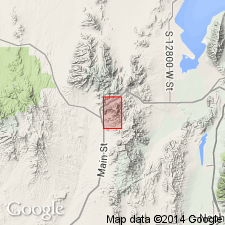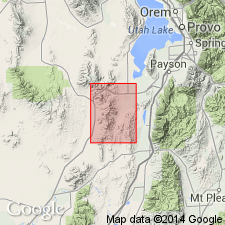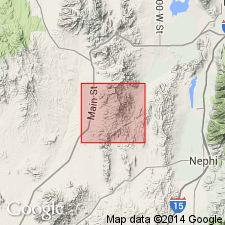
- Usage in publication:
-
- Swansea rhyolite*
- Modifications:
-
- First used
- Dominant lithology:
-
- Rhyolite
- AAPG geologic province:
-
- Great Basin province
Summary:
First published use as a unit mapped with the Packard rhyolite. Intent to name, source of name, and type locality not stated. Packard and Swansea mapped together. They occur in northern part of quad in Utah Co, UT on the Wasatch uplift and Juab Co, UT in the Great Basin province, as well as in three smaller areas in southern part of quad. [No way to tell if Swansea is present in all the exposures.] Town of Swansea is in T10S, R3W. Chemical analyses. Termed a quartz porphyry on p. 638. No distinctive discussion of the Swansea. Of Tertiary age, and older than Tintic andesite.
Source: GNU records (USGS DDS-6; Denver GNULEX).

- Usage in publication:
-
- Swansea rhyolite*
- Modifications:
-
- Overview
- AAPG geologic province:
-
- Great Basin province
- Wasatch uplift
Summary:
Forms one main mass nearly 3/5 of a mi long averaging a quarter mi wide between Robinson and Silver City, T10S, R3W, Juab Co, UT in the Great Basin province, and a smaller mass just southeast of Robinson. Represented in a small dike on Quartzite Ridge to north. A more complete description given in this report than in Tower and Smith (1899), so description generalized here. Consists of dark gray or greenish gray where not affected by weathering or silicification, but prevailing color is pink that bleaches to light gray or white. Is dense to very fine grained porphyritic in texture. Has a thoroughly crystallized groundmass. Recognizable phenocrysts which form about 30 percent of the rock are feldspar, quartz and biotite. The only distinctive megascopic feldspar is alkalic. Detailed descriptions. Chemical composition table. Geologic map. Classified as a toscanose. Assigned a Tertiary, post-Eocene age.
Source: GNU records (USGS DDS-6; Denver GNULEX).

- Usage in publication:
-
- Swansea Quartz Monzonite*
- Modifications:
-
- Age modified
- AAPG geologic province:
-
- Great Basin province
Summary:
Probably injected near northern border of [unnamed] caldera before its collapse. Shown on a geologic sketch map in a small area on east side of Tintic valley west of 112 degrees 07' 30" and north of 39 degrees 52' 30", Juab Co, UT in the Great Basin province, as an Oligocene unit younger [?] than the Packard and Fernow Quartz Latites and older than the latite of Tintic Mountain. No discussion of age change from Eocene of earlier reports to Oligocene in this report.
Source: GNU records (USGS DDS-6; Denver GNULEX).
For more information, please contact Nancy Stamm, Geologic Names Committee Secretary.
Asterisk (*) indicates published by U.S. Geological Survey authors.
"No current usage" (†) implies that a name has been abandoned or has fallen into disuse. Former usage and, if known, replacement name given in parentheses ( ).
Slash (/) indicates name conflicts with nomenclatural guidelines (CSN, 1933; ACSN, 1961, 1970; NACSN, 1983, 2005, 2021). May be explained within brackets ([ ]).

